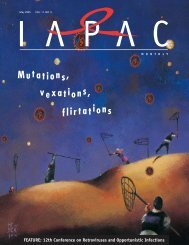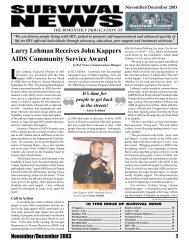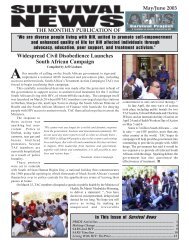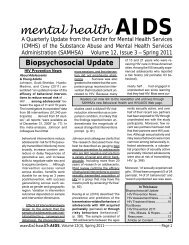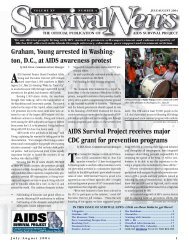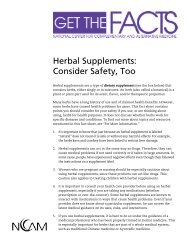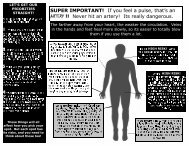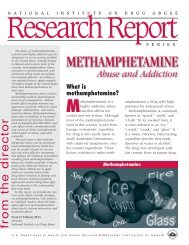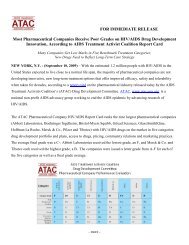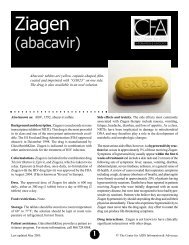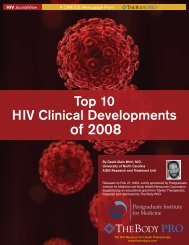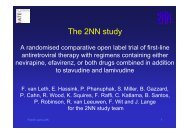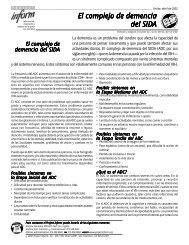HeAlTH INFormATioN & VieWs - CD8 T cells - The Body
HeAlTH INFormATioN & VieWs - CD8 T cells - The Body
HeAlTH INFormATioN & VieWs - CD8 T cells - The Body
You also want an ePaper? Increase the reach of your titles
YUMPU automatically turns print PDFs into web optimized ePapers that Google loves.
<strong>The</strong> New<br />
Old-School Activist:<br />
JESSICA<br />
WHITBREAD<br />
Now studying at York University in Toronto,<br />
Jessica Whitbread was diagnosed with HIV<br />
almost a decade ago, at age 21. Like some of<br />
her fellow activists and artists at the beginning<br />
of the epidemic, Whitbread takes a<br />
blunt approach to what it is like to live with<br />
HIV and believes strongly in the role of art to<br />
both shock and educate.<br />
Whitbread put her belief into action when she collaborated<br />
with queer feminist artist Allyson Mitchell to create a<br />
poster as part of a 2011 Day With(out) Art campaign led by<br />
AIDS ACTION NOW! <strong>The</strong> attention-grabbing “Fuck Positive<br />
Women” (see image, right) was one of a series of<br />
posters created by local Toronto artists to highlight current<br />
issues around HIV. Merging the worlds of art and activism,<br />
the controversial posters were plastered across Toronto<br />
during the weeks leading up to December 1 (World AIDS<br />
Day) to provoke discussion and dialogue.<br />
While the reality of living with HIV has changed since the<br />
early days of the epidemic, the art created by Whitbread<br />
and Pérusse carries echoes from that time: It reminds a<br />
too-complacent world that HIV still affects many lives. “We<br />
are not losing creative artists on the same scale as 15 years<br />
ago, but the impact on individual lives has been immense,”<br />
says the Canada Council’s Bob Sirman. “HIV has impacted<br />
almost everyone, not just artists living with it.”<br />
Sirman says that art can be a medium for people to try to<br />
make meaning from what appears to be random and<br />
chaotic. “Whether it’s painting, theatre, writing, cinema or<br />
dance, art can be a powerful means of framing and<br />
expressing life’s narrative and making sense and meaning<br />
from it all. If art gives purpose to the artist, then, of course,<br />
it is healing as well.” ✚<br />
Winnipegger Peter carlyle-gordge is a former writer for Macleans,<br />
Time canada and <strong>The</strong> Financial Post. he has also worked as a cBc<br />
Radio broadcaster and producer and is a former UK correspondent<br />
for <strong>The</strong> Toronto Star. In the 1980s he was president of the Village<br />
clinic (now Nine circles community health centre), a key player in<br />
the hIV epidemic in Manitoba.<br />
THE POSITIVE SIDE OF ART<br />
<strong>The</strong> Positive Side has a long history of celebrating hIV- positive<br />
canadian artists. “Not Your Average Joe” in the Spring/Summer<br />
2005 issue featured an interview with celebrated Vancouver<br />
artist Joe Average, who created the “One World, One hope”<br />
image for the XI International AIDS conference held in his hometown<br />
in 1996—the same conference that announced the results<br />
“Fuck Positive Women,” 2011<br />
“Sometimes you wake people up by provoking<br />
them,” says co-creator Jessica Whitbread. “Our<br />
aim was to make people realize that a woman<br />
may be positive but she is also a mother, a daughter,<br />
a lover, a friend, a wife, a human being.”<br />
Needlework may imply a traditionally feminine<br />
and passive pursuit, but the message is defiant<br />
and empowering. “Why can’t we express an<br />
urgent, horny, powerful and open message about<br />
positive women and sexuality?” asks Allyson<br />
Mitchell, who collaborated with Whitbread on<br />
the piece. “Why aren’t women allowed to be subjects<br />
of their sexuality rather than objects?”<br />
of the first effective anti-hIV treatments. canada Post later used<br />
his iconic image on a stamp.<br />
<strong>The</strong> Art Positi+ve column that runs in every issue of <strong>The</strong> Positive<br />
Side shares the stories of artists living with hIV and has featured<br />
Montrealers Shayo and Laurette Lévy, haligonian Simon Thwaites,<br />
Aboriginal artists Ron horsefall and Wabishki Myeengun, plus<br />
many others. check out www.positiveside.ca to read more about<br />
hIV-positive creative types from all corners of this country.<br />
Summer 2012 THE POSITIVE SIDE<br />
21



